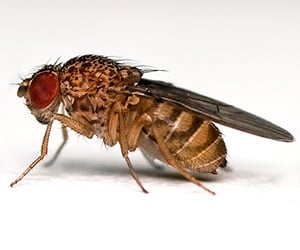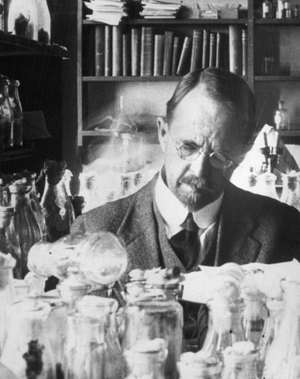Drosophila melanogaster: The Fruit Fly.
by
 If fruit flies could have an ego and could understand their contributions to research they would be pretty proud little model organisms. They would walk around on your fruit like, “ha! How about that? Whose banana now? This is my banana now…”
If fruit flies could have an ego and could understand their contributions to research they would be pretty proud little model organisms. They would walk around on your fruit like, “ha! How about that? Whose banana now? This is my banana now…”
These little flies have been a central tool in our understanding of modern genetics as well as the identification of conserved cellular signaling pathways across metazoan organisms. Of course, it wasn’t just the flies… a large community of amazing researchers have recognized the utility of Drosophila to understand biology. (Um, you’re going to have to share the banana there little guy, thanks…)

Eric Wieschaus in the lab…
100 years of Drosophila melanogaster research.
It was 100 years ago that the first Drosophila research paper was published. In 1910 Dr. Thomas Hunt Morgan published a paper entitled “Sex limited inheritance in Drosophila”[1] from work done in his famous “fly room” at Columbia University. It was with Morgan’s work that Drosophila genetics began. Morgan and his students examined and isolated mutant fly lines and through their analysis provided evidence that genes are carried on chromosomes and thus form the physical basis of heredity. Morgan subsequently was awarded the Nobel Prize in 1933 for work done over 17 years at Columbia University. It was a huge contribution to our understanding of modern genetics, and was done through observations of genetic crosses and following mutations through generations.
Since 1910 Drosophila research has grown extensively and contributed enormously to our understanding of biology, especially in the fields of genetics and developmental biology.

Thomas Hunt Morgan in the fly room. This picture is from a paper published by Gerry Rubin and E.B. Lewis, both very influential Drosophila biologists in their own right.
Large scale screens in Drosophila melanogaster.
One of the most powerful aspects of Drosophila melanogaster research has been the ability to do large-scale screens. In forward genetic screens a large number of flies with mutations are generated (by feeding a mutagenic chemical for example) and these flies are screened for abnormal phenotypes in the biological process of interest. Let’s say you are interested in how a neuron sends projections to another neuron. You can generate a whole bunch of mutants and look for those with abnormal neuronal projections. The relevant gene can then be identified and further studied to understand its role in neuronal biology.
Many important screens have been performed in Drosophila. They have identified and characterized major signaling pathways and cellular processes that are conserved from flies to mammals. One of the most famous Drosophila screens was done by C. Nusslein-Volhard and E. Wieschaus and published in 1980[3]. They were interested in the process of embryonic development, and a forward screen was performed to identify genes required for normal development. Mutant fly lines were established (27,000 of them!) and from these, 139 mutations affecting embryogenesis were characterized. Of these, 15 were described in their classic 1980 Nature paper. For this work they were awarded the Nobel Prize in 1995. Importantly, these central genes and pathways are highly conserved in their roles during mammalian development as well.
The genetic tools in Drosophila melanogaster research are awesome!
Biology research using Drosophila is empowered by the combination of a large number of genetic tools for experimentation and the fast speed of the fly life cycle. Researchers have developed and continue to develop genetic tools to perform all sorts of manipulations. You can express transgenes with tissue or cell type specificity (where the gene is expressed) and with temporal control (on/off). You can mark a dividing cell and all of its descendants to study lineages. You can mark lineages while also over-expressing or mutating a gene specifically in that lineage. And all of this is relatively cheap and fast!
In studying Drosophila biology one is not so limited by the time it takes to do an experiment or the genetic tools available. Instead you are faced with a large palette of tools and the challenge becomes, what will you do? What ideas will you test?
What makes Drosophila melanogaster research so great?
- The Drosophila community is very open. The accepted standard is to share reagents within the research community. There is an excitement to do the work.
- Availability of genetic tools and reagents (for mutant analysis and over-expression analysis).
- Flies have 4 pairs of chromosomes, a manageable number.
- Males lack recombination, making genetics easier.
- ‘Balancer chromosomes’ which contain multiple inversions of DNA (this blocks recombination) allow for easy isolation and maintenance of homozygous lethal mutations.
- Short life cycle (=quick experimentation = your advisor expects a lot!).
- High fecundity (=easy to rear = take a week off! The flies will be fine!).
- No regulatory considerations.
- Very low cost of set up, maintenance and experimentation.
As a graduate student, one of the best aspects of Drosophila research is the ability to move quickly and creatively in new directions. For training purposes this is good. You can learn from your mistakes! It forces you to say, okay, given so many options, what should I do? And after I characterize one aspect of this biological process, what is the next question?
What’s not so great about flies?
- You can’t freeze fly lines for later use. This means that all the mutant lines in the lab have been maintained over time.
- Lots of Drosophila labs these days are interested in studying complex phenotypes like cancer, diabetes, obesity, or ageing to name a few. Not only are we not sure how conserved these aspects of biology are across metazoans, but even if we Drosophila researchers are convinced ourselves, often our scientific colleagues are not. Therefore, our work might be less widely read or may fall on ears that are not interested. As an example, can we generate screens to identify genes involved in cancer metastasis in Drosophila? Is there true cellular metastasis in this organism that resembles that of mammals?
What’s in the future for Drosophila melanogaster biology research?
Drosophila research will continue to be powerful due to the genetic tools available, the low cost of the research and the relative ease and speed of large-scale screens. At the level of hypothesis driven research and also unbiased screens, Drosophila biologists will continue to make major contributions in genetics, cellular biology, and continue to make contributions relevant to human disease. If we were all artists, I imagine the biologist working with fruit flies would be analogous to the most experimental of artists, casting a wide net, working with new materials – Finding new ideas through creative play.
Kate is a graduate student of Developmental Biology in her 4th year of grad school at Washington University in St. Louis. When she’s not in the lab working with fruit flies she loves to go for hikes and ride horses. After grad school she’s determined to find a way to have a small farm where she can get up early, walk with happy dogs to the barn, and feed the horses.
[1] SEX LIMITED INHERITANCE IN DROSOPHILA. Morgan TH. Science. 1910 Jul 22;32(812):120-122.
[2] Thomas Hunt Morgan picture from A brief history of Drosophila‘s contributions to genome research. Rubin GM, Lewis EB. Science. 2000 Mar 24;287(5461):2216-8.
[3] Mutations affecting segment number and polarity in Drosophila. Nüsslein-Volhard C, Wieschaus E. Nature. 1980 Oct 30;287(5785):795-801.
See other articles in the series:
- Research’s Next Top Model (Zebrafish)
- EEK! The Mouse.
- Getting to Know Your Worms (C. elegans)
- Saccharomyces cerevisiae a.k.a Budding/Baker’s/Brewer’s Yeast
- The Almighty Fungi: The Revolutionary Neurospora crassa
- We’re Gonna Need a Bigger Lab: Large Animal Models in Research
- Tetrahymena: Little Creature, Big Discoveries
.
.


Spencer
wrote on October 18, 2011 at 12:55 pm
Used this article as a reference for a paper on the evolutionary analysis of Drosophila, great source with many good points.
Luke
wrote on February 19, 2012 at 10:30 am
Lovely article.. I have some additional information on drosophila melanogaster and I believe its relevant to this article.